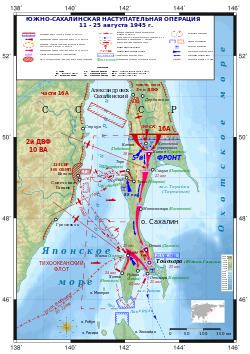Dates 11 Aug 1945 – 25 Aug 1945 Location Sakhalin, Siberia, Russia | Result Soviet Victory | |
 | ||
100,000 men 29,000 men (including 10,000 reservists) Unknown Red Army casualties
Pacific Fleet 89 killed Northern Army 700-2,000 killed, 18,302 PoW
3,500-3,700 Japanese civilian casualties Similar Volcano and Ryukyu Is, Attack on Yokosuka, Invasion of the Kuril Islands, Battle of Mutanchiang, Soviet–Japanese War | ||
Invasion of south sakhalin
The Invasion of South Sakhalin also called the Battle of Sakhalin (Russian: Южно-Сахалинская операция) and (Japanese: 樺太の戦い) was the Soviet invasion of the Japanese territorial portion of Sakhalin island known as Karafuto Prefecture. The invasion was part of the Soviet–Japanese War (1945).
Contents
- Invasion of south sakhalin
- Background
- Soviet Union
- Empire of Japan
- Karafuto Line
- Soviet naval invasion and blockade
- Aftermath and casualties
- References
Background
In the Treaty of Portsmouth in 1905, control of the island was split, with the Russian Empire controlling the northern half and the Japanese controlling the southern portion under the 50 parallel north. It was known in Japan as the Karafuto Prefecture and the Northern District.
During the Yalta Conference of 1945, Soviet Union leader Joseph Stalin pledged to enter the fight against the Empire of Japan "in two or three months after Germany has surrendered and the war in Europe is terminated." This would create another strategic front against Japan necessary to end the War. As a result of their participation the Soviets would be awarded South Sakhalin and the Kuril Islands among other concessions. The United States would aid the Soviet Army in Project Hula in preparation for the invasion.
On 9 August, the Soviet Union repudiated the Soviet–Japanese Neutrality Pact and launched a full-scale invasion of Manchuria in the Soviet-Japanese War of 1945.It should be noted that this invasion occurred 2 days after the United States bombing of Hiroshima. This included the planned invasion of Japanese territory in Sakhalin. The main purpose of the invasion was to clear Japanese resistance and then — within 10 to 14 days — be prepared to invade Hokkaido, the northernmost of Japan's home islands.
Soviet Union
Empire of Japan
Karafuto Line
On 11 August, the Soviet 16th Army commenced the ground invasion from northern Sakhalin of the southern portion of Sakhalin Island controlled by Japan. The Soviet advance was halted by the strenuous Japanese defense of the Karafuto Fortress defense line. The Soviet 16th Army which consisted of roughly 20,000 men and supported by 100 tanks outnumbered the Japanese defenders 3 to 1. However the Soviet advance was minimal and held off for four days on the Karafuto line.
On 15 August, Imperial Japanese headquarters issued the order to halt all offensive combat operations and engage in a cease-fire dialogue; however, the 5th Area Army issued a contrary order to the 88th Division to defend Sakhalin to the last man. The same day 3,000 Japanese troops surrendered the Karafuto Line. Japanese military casualties were 568 dead.
Soviet naval invasion and blockade
In order to speed up the invasion of Sakhalin island and relieve pressure on the ground invasion the Soviet Navy launched an amphibious assault operation against the key Japanese ports. A naval blockade of Sakhalin island was put into place to prevent the evacuation of Japanese troops. Although civilian convoys were targeted by Soviet submarines in the Aniva Gulf.
On 16 August, the Soviet coast guard ship Zarnitsa, four minesweepers, two transports, six gunboats and nineteen torpedo boats docked in Port Toro. Around 1,400 Soviet troops of the 365th Separate Marine Battalion and one battalion of the 113th Infantry Brigade landed in Toro (now Shakhtyorsk) and engaged a Japanese garrison of 200 men. Toro was captured and the next day they captured four populated areas and the port city of Esutoru (now Uglegorsk), Anbetsu (now Vozvrashcheniye) and Yerinai. Japanese casualties were 100 killed, 150 wounded and 30 captured. Soviet casualties were 12 killed.
On 20 August, 3,400 troops of the Soviet Navy combined marine battalion and the 113th Infantry Brigade landed in Port Maoka (now Kholmsk). The landing party was met with fierce Japanese defense. A few naval vessels were damaged which led to the Soviet response of intense naval bombardment of the city, causing approximately 600 to 1,000 civilian deaths. Maoka was captured on 22 August, with heavy Japanese resistance continuing throughout the city. Japanese military casualties in this battle were 300 killed and 600 captured. Soviet casualties were 60 army soldiers killed and 17 naval infantry killed.
On 25 August, 1,600 Soviet troops landed in Otomari (now Korsakov). The Japanese garrison of 3,400 men surrendered. The same day the remnants of the Japanese 88th Division surrendered to the 16th Army and the city of Toyohara was captured without resistance officially ending the Invasion of Sakhalin.
Aftermath and casualties
Japanese casualties are approximately 700-2,000 soldiers killed and 3,500-700 civilians killed. Around 18,202 were captured and many of the Japanese prisoners of war in Sakhalin were sent to labor camps in Siberia and held after the war. At least 100,000 Japanese civilians fled Soviet occupation during the invasion. The capture of Sakhalin Island proved a necessary prerequisite for the Invasion of the Kuril Islands. Following the Japanese surrender Sakhalin island was granted to the U.S.S.R which renamed it to Sakhalin Oblast.
